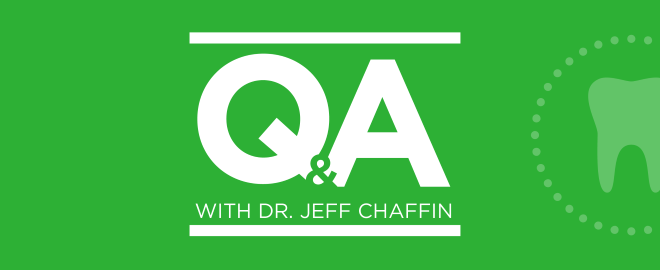Q&A with Dr. Jeff: Understanding the basics of tooth decay and cavities
Posted on September 5, 2024 in Healthy You

Tooth decay and cavities are common concerns, but understanding the process behind them can help you keep your smile healthy. In this Q&A, Dr. Jeffrey Chaffin, Chief Dental Officer at Delta Dental of Iowa, explains everything you need to know about cavities.
Q: What exactly is tooth decay, and how does it happen in our mouths?
Dr. Chaffin: Tooth decay, or a cavity, usually begins when the hard surface of your tooth, called enamel, is damaged. It is caused by the bacteria in your mouth that is usually fueled by high levels of sugar and frequent snacking.
Q: Are there different stages of tooth decay? If so, what are the signs and symptoms people should watch out for at each stage?
Dr. Chaffin: There are stages of a cavity. The first stage is called demineralization, and the tell-tale sign is white spots on your teeth. These white spots are visible and are a pre-cavity. The demineralization is the early breakdown of the outer portion of the tooth.
The second stage is called enamel decay. This is characterized by a small hole being created by the cavity in the hard outer part of the tooth (the enamel). This area is usually darker than the rest of the tooth and can be sensitive as well.
The third stage is called dentin decay. The dentin is the next layer of your tooth below the enamel. The dentin is much softer than the enamel. When the cavity reaches the dentin, this is an advanced cavity, but it hasn’t reached the pulp (nerve) of the tooth yet.
The fourth stage is when the cavity reaches the pulp, and this can be very painful. The pulp of the tooth is in the middle and contains the nerves and blood vessels for the tooth. When the cavity reaches this part of the tooth, a root canal is most likely needed to save the tooth.
The last stage is called an abscess. This is when a cavity reaches the pulp and is not treated and an infection occurs, usually at the end of the tooth. This infection can surround the root tip and cause swelling and pain.
Q: Besides brushing and flossing, are there any other preventive measures to avoid cavities?
Dr. Chaffin: Regular daily self-hygiene is the most important. Brush twice a day with a fluoride toothpaste and floss as well. The biting surface of back teeth (molars) have many grooves in them and the toothbrush can’t properly clean. Dental sealants are highly effective in preventing cavities in those biting surfaces. Dental sealants should be placed within 6 months to a year of those teeth erupting, as that is when those teeth are most susceptible to cavities.
Q: What are some dietary habits that can contribute to tooth decay, and what are some healthier alternatives?
Dr. Chaffin: Sugars are part of our daily life, but they also contribute to tooth decay. While we can’t avoid sugars completely, minimizing sugar can help prevent cavities. It’s also important to have less frequent exposure to sugars. For example: If you are going to have a candy bar, enjoy it and be done as opposed to having a jelly bean every 5 minutes. When we consume sugar, our mouth becomes more acidic, and there is a 15-20-minute window where cavities can happen. So, the frequency of the sugar consumption is important.
Drinking water is very important for our overall health and plays a main role in preventing cavities as well. Water, especially fluoridated water, helps keep our teeth healthy.
Q: How important is it to see a dentist regularly for cavity prevention? What can dentists do to detect and treat cavities in the early stages?
Dr. Chaffin: Seeking routine care from your dentist can prevent cavities. If you do develop a cavity, this can be identified early and require only a small filling. Sometimes when cavities are identified early, the process can be reversed using items like professional fluoride. We recommend seeing your dentist twice a year.
Q: What cavity treatment options are available? Are there any ways to prevent cavities from getting worse before my dental appointment?
Dr. Chaffin: For small/early cavities, your dentist may be able to reverse these without a dental filling. Materials like professional fluoride can reverse early and small cavities. Once the cavity gets larger and breaks through the enamel, a filling is needed. Your dentist has different filling options and can discuss those with you. If/when the cavity breaks down a majority of the tooth, your dentist may need to place a dental crown to stabilize the tooth.
Q: Are there risk factors that make someone more susceptible to cavities?
Dr. Chaffin: There are numerous risk factors that make one susceptible to cavities. Many think it’s their genetics, but genetics play a very minor role.
The bigger risk factors are diet, snacking, oral hygiene and saliva. A diet of sugary foods and acidic drinks are one of the major risk factors for cavities. Constantly snacking/sipping between meals is another risk factor.
Your saliva plays an important role in preventing cavities, too. Saliva not only washes away food material, but it also buffers the acidic environment caused by the food we eat and drink. Some medications and diseases can greatly reduce our saliva. If this is the case for you, discuss ways to reduce potential cavities with your dentist. And lastly, your daily oral hygiene (brushing and flossing) plays a vital role in prevention.
Q: Is there anything else you think people should know about understanding tooth decay and cavities that you haven't already covered?
Dr. Chaffin: Prevention is the most important, because once you have a cavity that breaks through the enamel and a filling is placed, that filling will have to be replaced numerous times throughout your life. Each filling becomes a little bigger, and this cycle of replacements can be expensive.